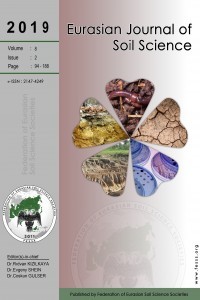
Eurasian Journal of Soil Science
Yazarlar: İmane ACHKOUK, Saida AARAB, Amin LAGLAOUİ, Mohammed BAKKALİ, Abdelhay ARAKRAK
Konular:Fen
DOI:10.18393/ejss.436181
Anahtar Kelimeler:Farmyard manure,Compost,Soil acidity,Incubation
Özet: Utilization of plant growth promoting rhizobacteria (PGPR) is now gradually increasing in agriculture and offers an attractive way to replace chemical fertilizers, pesticides, and supplements. This study was conducted with a view to isolate bacteria from the rhizosphere of the legume Lotus creticus (L. creticus) and to assess their plant growth promoting functional potentialities. A total of 113 rhizobacteria was isolated from the rhizosphere of L. creticus and were tested for their capacity of solubilizing tricalcium phosphate (TCP) on Pikovskaya (PVK) solid medium. Out of 29 phosphate solubilizing bacteria (PSB), 5 isolates were selected for their solubilization diameters (between 0.6 and 1.5 cm). These isolates were characterized for plant growth promoting (PGP) traits. The results showed that the highest concentration of indole acetic acid (IAA) was produced by LCR33 (19.08 ± 0.96 mg L-1). All 5 isolates could produce hydrogen cyanide (HCN), siderophores, ammonia and amino-cyclopropane carboxylate (ACC) deaminase. The isolates were evaluated for TCP solubilizing quantitative assay in PVK liquid medium. The concentrations of solubilized P were between 43.34±0.18 mg L-1 and 173.57±0.77 mg L-1. This solubilization was accompanied by a pH decrease of the culture media from 7 to 4.06. Furthermore, the 5 selected PSB were tested in vitro for antagonism against phytopathogenic fungus Fusarium oxysporum. In fact, all the PSB, were capable of inhibiting its growth and the highest percentages of inhibition were obtained for LCP27 and LCR33 (48.15±0.99% and 40.74±0.45%). Also, the effect of these 2 PSB on growth of L. creticus plants was investigated under greenhouse conditions. Significant increases were obtained for shoot and root length and dry and fresh matter production of plants as compared to the uninoculated control. These PSB could be recommended as biofertilizers for contributing to the rehabilitation of degraded soils.